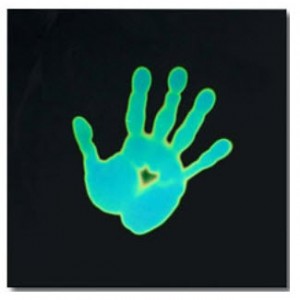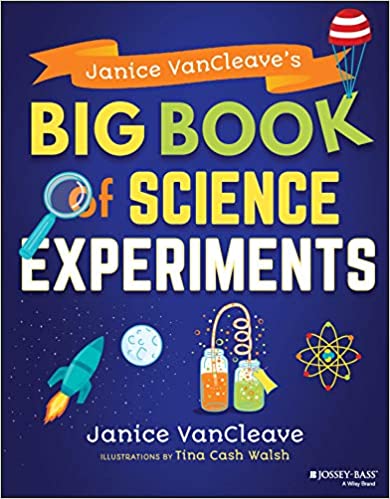Thermochromic (TC) materials change color in response to temperature changes.
The two basic types of thermochromic substances are liquid crystals and Leuco dyes.
Liquid Crystals (LCs) can be highly temperature sensitive, change to many colors, and are more expensive than leuco dyes.
The picture shows a liquid crystal sheet. Prior to being touched with a hand, the sheet was entirely black. The heat from the hand pressed against the sheet raised the temperature of the sheet where the hand was pressed. The color depends on the temperature. Thus as the sheet cools the color of the hand print will change. With their active temperature range, LC’s go through the colors of a rainbow. Above and below their active temperature range, LC’s are transparent. The black background is used to best display the color changes.
LC’s are reversible. This means that they can be used over and over again. If kept out of UV light and away from high temperatures and strong solvents, LC products will last for years.
LCR Hallcrest, Inc. formulate LC’s that can change temperature from -22 to +248ºF (-30 to 120ºC), and can be sensitive enough to detect changes as small as 0.2ºF. You can find detailed research information about liquid crystals on the LCR Hallcrest website. Interested in knowing how a LC thermometer is made? For details as well as diagrams, see All About Thermochromic Liquid Crystals.
Leuco Dyes (LD’s), like liquid crystals, change color with changes in temperature. LD’s are also reversible, meaning they change color back and forth as the temperature changes. It takes about a 5ºF (3ºC) temperature change for the LD to change color.
Why Thermochromic (TC) Materials Change Color
Liquid Crystals and Leuco Dyes change color in response to temperature changes. Remember that temperature is a measure of the average kinetic energy, which means the average molecular motion. Changes in the molecular motion due to temperature changes results in molecular shapes that reflect different amounts of visual light energy. Liquid crystals twist one way when heated and twist in the opposite direction when cooled. The direction and amount of twisting results in different reflection of visual light energy.
To better understand the color changes of thermochromic materials, it is important to understand why any object appears to have color. Note that I said–“appears to have color.” While color is listed as being a physical characteristic, color is not a physical part of an object. Instead, an objects color is due to the visual light energy the object reflects and how you perceive the color.
You see colors when visual light energy enters and stimulates nerves in your eyes. These nerves send a message to your brain and it is here that the message is decoded as a specific color. This is called visual perception.
Again, objects have color because they reflect visual light energy. The spectrum of visual light energy from least to most energy is: red, orange, yellow, green, blue, indigo, violet. Using the first letters of the colors spells out a man’s name ROY G. BIV. This mnemonic help me to remember the order of the visual light energy spectrum.
Objects appear white if they reflect the entire visual light energy spectrum. A white object is not transparent to visible light energy. This means that visible light energy is reflected by the object.
As a unit, the spectrum of visual light energy is called white light. Sunlight is an example of white light.
Objects appear black if they do not reflect any of the spectrum of visual light energy. When white light strikes an object and the light is absorbed with no reflection, the object appears to be black.
Objects appear clear and colorless when white light passes through it. The object is said to be transparent to visible light energy.
Stretch Your Brain
If you want to do a bit of reseach at the micro level, find out about the structures of liquid crystals. Liquid crystals change shape between the low-temperature crystal phase, through anisotropic chiral phase or twisted nematic phase, to the high-temperature isotropic liquid phase. Only the nematic mesophase has thermochromic properties; this restricts the effective temperature range of the material.
Both liquid crystals and Leuco dyes can be microencapsulation. For information about microiencapsulation, see LCR Hallcrest Microencapsulation of Liquid Crystals and Leuco Dyes
Blow Your Mind Research!
If you need the real nitty gritty about liquid crystals, check out the Hallcrest Advanced Research Liquid Crystal Handbook. My brain is still twirling from just skimming through this material. WOW! I think I understood this at one time in the past. I do recognize some of the terms. Maybe my brain needs to be defraged so that all the information is more organized.
Big Book of Science Experiments
A book of fun informative experiments about astronomy, biology, chemistry, earth science, and physics.

